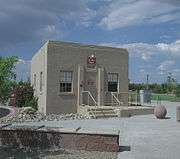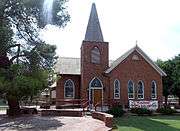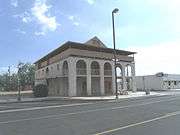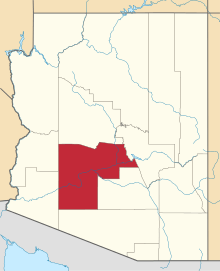Peoria, Arizona
| Peoria, Arizona | ||
|---|---|---|
| City | ||
|
Images, from top, left to right: Peoria Sports Complex sign, Peoria Presbyterian Church, Peoria Center for the Performing Arts, Rio Vista Community Park, Old Town Peoria, Pioneer Memorial Statue, Lake Pleasant Regional Park, WestWing neighborhood | ||
| ||
 Location in Maricopa County and the state of Arizona | ||
 Peoria, Arizona Location in the United States | ||
| Coordinates: 33°34′57″N 112°14′19″W / 33.58250°N 112.23861°WCoordinates: 33°34′57″N 112°14′19″W / 33.58250°N 112.23861°W | ||
| Country | United States | |
| State | Arizona | |
| Counties | Maricopa, Yavapai | |
| Government | ||
| • Mayor | Cathy Carlat | |
| Area | ||
| • City | 178 sq mi (461 km2) | |
| • Land | 174.5 sq mi (451.9 km2) | |
| • Water | 3.5 sq mi (9.0 km2) | |
| Elevation | 1,142 ft (348 m) | |
| Population (2010)[1] | ||
| • City | 154,065 | |
| • Estimate (2015)[2] | 171,237 | |
| • Rank | US: 146th | |
| • Density | 865.53/sq mi (334.19/km2) | |
| • Metro | 4,574,531 (US: 12th) | |
| Time zone | MST (no DST) (UTC-7) | |
| ZIP codes |
85345, 85381, 85382, 85383 85373 (Sun City) 85387 (Morristown) | |
| Area code(s) | 623 and 928 | |
| FIPS code | 04-54050 | |
| Website | http://www.peoriaaz.gov/ | |
Peoria /piˈɔːriə/ is a city in Maricopa and Yavapai counties in the State of Arizona. Most of the city is located in Maricopa County, while a tiny portion in the north is in Yavapai County. It is a major suburb of Phoenix. According to 2010 Census Bureau releases, the population of the city is 154,065.[1] Peoria is currently the sixth largest city in Arizona for land area, and the ninth largest for population. It was named after Peoria, Illinois. The word "peoria" is a corruption of the Illini word for "prairie fire."[3][4] It is the spring training home of the San Diego Padres and Seattle Mariners who share the Peoria Sports Complex. In July 2008, Money magazine listed Peoria in its Top 100 Places to Live.[5]
History
Initial settlement
Peoria sits in the Salt River Valley, and extends into the foothills of the mountains to the north. William John Murphy, who had worked on the Arizona Canal, recruited settlers to begin a community in Arizona, many of them from Peoria, Illinois. Four farming families left Illinois that fall to relocate to what is now Peoria, Arizona. An old desert road connecting Phoenix to the Hassayampa River near present-day Wickenburg was the only major transportation route in the area until 1887, when a new road was laid out. Named Grand Avenue, this road angled through the newly designed town sites of Alhambra, Glendale, and Peoria and became the main route from Phoenix to Vulture Mine. The settlers filed Peoria's plot map with the Maricopa County recorder on May 24, 1897, naming the settlement after their hometown.
The original plot map of Peoria included east and west streets (from south to north) Monroe, Madison, Jefferson, Washington, Jackson, Lincoln, Grant, and Van Buren. Streets going north and south were (from west to east) Almond (present-day 85th Avenue), Peach (present-day 84th Avenue), Orange (present-day 83rd Avenue), Vine (present-day 82nd Avenue), Walnut (present-day 81st Avenue), the plot was roughly from present-day Peoria and 85th avenues to Monroe Street and 85th Avenue to Monroe Street and 81st Avenue to 81st Avenue and south of the Desert Cove alignment.[6] On August 4, 1888, the Territory of Peoria, Arizona was granted a post office in its name and served a population of 27. Maricopa County supervisors defined the boundaries for School District Eleven, comprising forty-nine square miles, and the first class took place in an unoccupied brick store that faced north on Washington Street until Peoria's first school building, a one-room structure completed in 1891.
Early growth of the town
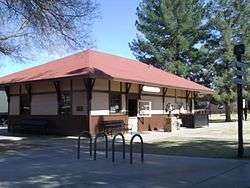
Between 1891 and 1895 a spur line of the Santa, Prescott and Phoenix Railroad was placed in Peoria along with Phoenix, Glendale, Alhambra, Hesperla, and Marinette. A small depot on 83rd Avenue just off Grand Avenue. The depot was sold to the city of Scottsdale in 1972 where it now resides at McCormick Stillman Railroad Park.
About 1919 the Peoria Chamber of Commerce formed. It operated as the informal government body until Peoria was incorporated in 1954. The Peoria volunteer fire district formed in 1920 and remained all volunteer until the mid-1950s. The three-story Edwards Hotel was built in 1918, followed by the Mabel Hood building in May 1920 at the southwest corner of Washington Street and 83rd Avenue. The John L. Meyer or "flatiron" building was completed in June 1920 and the O.O. Fuel's Paramount Theatre in July 1920 (It served as Fire Station 1 from 1950 until 2004). The town's first newspaper, The Peoria Enterprise, was printed weekly from November 14, 1917, to April 1921.
Peoria's first library was held at the women's club in 1920 until it moved to the old Peoria City Hall in 1975 (where the Peoria Center for the Performing Arts was constructed and currently sits). The library eventually moved to the Peoria Municipal Complex. In May 1959 the Women's Club gave the clubhouse to the City of Peoria.
Central School was built in 1906. By 1910, three additional classroom buildings were built next to the central school, and in 1918 another school building, containing an auditorium and four classrooms, was opened. In 1918 the attendance for Peoria schools was 190. School District Number Eleven was originally an elementary school district. Children going on to high school had to travel to Glendale High School. In 1919 the school board approved construction of Peoria High School.
Post-war development
Increased economic activity, combined with the presence of Luke Air Force Base and tremendous growth throughout the entire Valley—coinciding with the mass-production of air conditioning in the early 1950s—led to an increase in residential housing in Peoria. A postwar construction boom set the stage for Peoria to become a suburb of Phoenix, providing housing for the capital city as growth moved west.
In 1954, Peoria was home to 1,925 residents, including an area of 720 acres (2.9 km2). Peoria incorporated on June 7, 1954. A seven-member city council formed and held its first organizational meeting on June 14. By 1966 Peoria grew to encompass 3.1 square miles (8.0 km2) with 36 miles (58 km) of street. In 1968 the city passed a bond to issue securing the money to build a sewer system, which was completed in 1969. In 1970, Peoria began to transition to paid firefighting staff. From a population of 4,792 in 1970, the city grew to 12,351 in 1980 and 50,675 in 1990. Construction of the $30 million municipal complex began in 1988 at the edge of Peoria's Old Town. The Police Department opened in 1989, the main city hall building and courts in 1991, and the library in 1993.
Spring training has a long history in Peoria. From the late 1970s to 1990, Peoria's Greenway Sports Complex served as a minor-league training facility for the Milwaukee Brewers baseball team. This small facility was located at 83rd Avenue and the Greenway Road alignment, the location of the future Peoria Sports Complex. Construction of the new complex was approved in 1990. It was completed in 1994 and was the first Major League Baseball spring training facility in the county shared by two teams. The San Diego Padres and Seattle Mariners utilize the complex year round for spring training and player development.
Current developments
"In January, 2010, four months after breaking ground, Stirling Energy partner company Tessara Solar completed the 1.5 MW Maricopa Solar power plant in Peoria, Arizona, just outside Phoenix. The power plant is comprised of 60 SES SunCatchers." The SunCatcher is described as "a large, tracking, concentrating solar power (CSP) dish collector that generates 25 kilowatts (kW) of electricity in full sun. Each of the 38-foot-diameter collectors contains over 300 curved mirrors (heliostats) that focus sunlight onto a power conversion unit, which contains the Stirling engine. The dish uses dual-axis tracking to follow the sun precisely as it moves across the sky."[7]
Peoria's identity is more related to resort and leisure living than the past, as that type of lifestyle migrates from the northeast Valley to Peoria. Peoria's economic plan focuses on establishing the new Loop 303 freeway corridor as an industrial, commercial, mixed development use and less on traditional residential development. In July 2008 Money Magazine listed Peoria in the Top 100 Places to Live.[5]
Geography
Peoria is located at 33°34′57″N 112°14′19″W / 33.58250°N 112.23861°W (33.582439, −112.238548).[8]
According to the United States Census Bureau, the city has a total area of 141.7 square miles (367 km2), of which, 138.2 square miles (358 km2) of it is land and 3.5 square miles (9.1 km2) of it (2.44%) is water.
Peoria has now annexed over 170 square miles (440 km2) and is in two counties Maricopa County and Yavapai County. It is technically the largest incorporated city in Yavapai County even though almost all of Peoria's current population resides on the Maricopa side.
The Agua Fria River and New River are the only rivers that flow through Peoria. The Agua Fria River is usually dry due to the New Waddell Dam that holds back Lake Pleasant in the northern end of the city. The New River is usually dry due to flood control measures and New River Dam. There are multiple washes and creeks that flow through the city as well, one of the most significant is the Skunk Creek due to its trails and connectivity with nearby Glendale.
Peoria has many mountains and hills in the northern end. Some include Sunrise Mountain, West Wing Mountain, East Wing Mountain, Calderwood Butte, Cholla Mountain, White Peak, Hieroglyphic Mountains, and Twin Buttes.
The street system of Peoria is based on the city of Phoenix traditional grid system, with most roads oriented either north-south or east-west. The zero point is in downtown Phoenix at Central Avenue and Washington Street. Since Peoria is always west of zero, its north-south numbered Streets are Avenues. Major arterial streets are spaced one mile (1.6 km) apart (until you are north of roughly Pinnacle Peak Road). The one-mile (1.6 km) blocks are divided into approximately 800 house numbers although this varies. 83rd Avenue, being 8300 West. The numbers in Phoenix start at Central Avenue at a half-mile increment, going west to 7th Avenue ½ mile from Central but considered the arterial. Then the numbers go to 19th (1 mile from 7th), 27th, 35th, 43rd, 51st, 59th, 67th (in many places Peoria's eastern border), 75th, 83rd, 91st, 99th, and so on. In northern Peoria streets are more curvilinear and begin to not follow the north-south route due to rivers, mountains, and terrain challenges. The northern end of the city does still follow the alignment theory and still has blocking according to Phoenix.
Climate
| Climate data for Peoria, Arizona | |||||||||||||
|---|---|---|---|---|---|---|---|---|---|---|---|---|---|
| Month | Jan | Feb | Mar | Apr | May | Jun | Jul | Aug | Sep | Oct | Nov | Dec | Year |
| Record high °F (°C) | 87 (31) |
89 (32) |
98 (37) |
103 (39) |
113 (45) |
122 (50) |
122 (50) |
116 (47) |
114 (46) |
108 (42) |
95 (35) |
84 (29) |
122 (50) |
| Average high °F (°C) | 68 (20) |
72 (22) |
78 (26) |
86 (30) |
95 (35) |
104 (40) |
107 (42) |
105 (41) |
100 (38) |
89 (32) |
76 (24) |
66 (19) |
87.2 (30.8) |
| Average low °F (°C) | 42 (6) |
45 (7) |
50 (10) |
56 (13) |
65 (18) |
73 (23) |
80 (27) |
79 (26) |
73 (23) |
60 (16) |
48 (9) |
41 (5) |
59.3 (15.3) |
| Record low °F (°C) | 20 (−7) |
24 (−4) |
24 (−4) |
32 (0) |
27 (−3) |
51 (11) |
62 (17) |
54 (12) |
48 (9) |
35 (2) |
28 (−2) |
21 (−6) |
20 (−7) |
| Average precipitation inches (mm) | 1.04 (26.4) |
1.33 (33.8) |
1.07 (27.2) |
0.33 (8.4) |
0.10 (2.5) |
0.04 (1) |
0.92 (23.4) |
1.2 (30) |
0.82 (20.8) |
0.61 (15.5) |
0.68 (17.3) |
1.05 (26.7) |
9.19 (233) |
| Source: The Weather Channel [9] | |||||||||||||
 |
Sun City and Surprise | Yavapai County | Yavapai County and Phoenix, Arizona |  |
| Sun City and Surprise and Youngtown | |
Phoenix and Glendale | ||
| ||||
| | ||||
| Glendale | Glendale | Glendale |
Demographics
| Historical population | |||
|---|---|---|---|
| Census | Pop. | %± | |
| 1910 | 300 | — | |
| 1920 | 2,371 | 690.3% | |
| 1930 | 1,748 | −26.3% | |
| 1960 | 2,593 | — | |
| 1970 | 4,792 | 84.8% | |
| 1980 | 12,171 | 154.0% | |
| 1990 | 50,675 | 316.4% | |
| 2000 | 108,364 | 113.8% | |
| 2010 | 154,065 | 42.2% | |
| Est. 2015 | 171,237 | [10] | 11.1% |
| U.S. Decennial Census[11] 2015 Estimate[2] | |||
As of the census of 2000, there were 108,364 people, 39,184 households, and 29,309 families residing in the city. The population density was 784.0 people per square mile (302.7/km²). There were 42,573 housing units at an average density of 308.0 per square mile (118.9/km²). The racial makeup of the city was 84.95% White, 2.78% Black or African American, 0.68% Native American, 1.92% Asian, 0.11% Pacific Islander, 7.09% from other races, and 2.48% from two or more races. 15.41% of the population were Hispanic or Latino of any race.
There were 39,184 households out of which 37.7% had children under the age of 18 living with them, 62.0% were married couples living together, 9.1% had a female householder with no husband present, and 25.2% were non-families. 20.5% of all households were made up of individuals and 10.3% had someone living alone who was 65 years of age or older. The average household size was 2.73 and the average family size was 3.16.
In the city the population was spread out with 28.4% under the age of 18, 6.7% from 18 to 24, 30.6% from 25 to 44, 19.8% from 45 to 64, and 14.4% who were 65 years of age or older. The median age was 36 years. For every 100 females there were 92.5 males. For every 100 females age 18 and over, there were 88.0 males.
The median income for a household in the city was $52,199, and the median income for a family was $58,388. Males had a median income of $40,448 versus $29,205 for females. The per capita income for the city was $22,726. About 3.3% of families and 5.3% of the population were below the poverty line, including 5.8% of those under age 18 and 6.3% of those age 65 or over.
Government
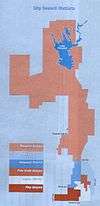
In November 1983, Peoria citizens voted to require the direct election of the mayor and in 1989, established a city council district system that separated the city into six geographical districts, each of which elects one member of the city council. The districts are redrawn after every census. The current mayor is Cathy Carlat. The current City Manager is Carl Swenson, ICMA-CM. Jeff Tyne, Susan Daluddung and Julie Ayers, ICMA-CM are the Deputy City Managers. The current Chief of Police is Roy Minter Jr. and the Fire Chief is Bobby Ruiz.
Education
Peoria city limits are mostly within the Peoria Unified School District ("PUSD"),[12] however, some portions of the northeastern end of the city limits are within the Deer Valley Unified School District ("DVUSD"), portions of the northwestern end of the city are within the Nadaburg Unified School District, and portions of the city in Yavapai County lie within the Wickenburg Unified School District. PUSD has seven high schools, four of which are actually within the city limits of Peoria (the other three are in the city limits of Glendale) including:
PUSD High Schools within Peoria
- Peoria – opened 1922
- Centennial – opened 1990
- Sunrise Mountain – opened 1996
- Liberty – opened 2006
PUSD High Schools within Glendale
- Cactus – opened 1977
- Ironwood – opened 1986
- Raymond S. Kellis – opened 2004
PUSD elementary schools within the city limits are Alta Loma, Apache, Cheyenne, Copperwood, Cotton Boll, Country Meadows, Coyote Hills, Desert Harbor, Frontier, Ira Murphy, Lake Pleasant, Oakwood, Oasis, Parkridge, Paseo Verde, Peoria, Santa Fe, Sky View, Sunset Heights, Sun Valley, Sundance, Vistancia and Zuni Hills. Though the city of Peoria has 23 PUSD elementary schools, some students fall within the boundaries of the other 10 PUSD elementary schools located inside the city of Glendale.
DVUSD schools within the Peoria city limits are Terramar and West Wing Elementary schools.
Additionally the city is served by numerous publicly funded charter high schools and elementary schools.
Trine University opened a branch campus in Peoria in 2013.[13]
Peoria is also home to two beauty schools and over 25 beauty schools within 30 miles.[14]
Notable people
- A Change of Pace – rock band
- Jaff Decker – professional baseball player [15]
- The Format – rock band
- Bob Howry – professional baseball pitcher[16]
- Kyle Kosier – NFL football player (Dallas Cowboys)
- Mary Peters – former United States Secretary of Transportation.[17]
- Ichiro Suzuki – professional baseball player[18]
- Tim Toone – professional football player. Picked by the Detroit Lions 2010 NFL Draft.
Historic properties in Peoria
There are numerous properties in the city of Peoria which are considered to be historical and have been included either in the National Register of Historic Places[19] or the listings of the Peoria Register of Historic Places. The following are images of some of these properties with a short description of the same.
Historic Old Town Peoria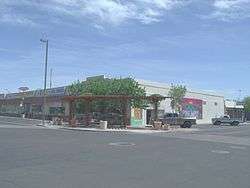 Old Town Peoria as seen from an intersection between Washington St. and 83rd. Ave. (NRHP = National Register of Historic Places)[19] (PRHP=Peoria Register of Historic Places-listed)[20] | ||||||||||||
|---|---|---|---|---|---|---|---|---|---|---|---|---|
|
Sister cities
- Peoria has one sister city:[21]
![]() Ards, County Down, Northern Ireland
Ards, County Down, Northern Ireland
See also
References
- 1 2 "American FactFinder". United States Census Bureau. Retrieved June 18, 2012.
- 1 2 "Population Estimates". United States Census Bureau. Retrieved June 18, 2016.
- ↑ "Peoria at center of 'Land of great abundance' 10/27/02". Retrieved February 2, 2009.
- ↑ "Peoria's History". Retrieved August 17, 2008.
- 1 2 "Top Places to Live". CNN. Retrieved August 17, 2008.
- ↑ https://www.peoriaaz.gov/uploadedFiles/Peoriaaz/Departments/Community_Development/Planning_and_Zoning/Historic_Preservation/2012HPMasterPlanFINAL.pdf
- ↑ Wilson, Alex (April 29, 2010). "Building Green's Product of the Week". Stirling SunCatcher with "Heat Engine" Technology. Building Green.com. Retrieved March 3, 2011.
- ↑ "US Gazetteer files: 2010, 2000, and 1990". United States Census Bureau. February 12, 2011. Retrieved April 23, 2011.
- ↑ "Monthly Averages for Peoria, AZ". The Weather Channel. 2010. Retrieved November 30, 2010.
- ↑ "Annual Estimates of the Resident Population for Incorporated Places: April 1, 2010 to July 1, 2015". Retrieved July 2, 2016.
- ↑ "U.S. Decennial Census". Census.gov. Archived from the original on May 11, 2015. Retrieved May 7, 2014.
- ↑ "Municipalities and Schools within the PUSD." (Archive) Peoria Unified School District. Retrieved on October 18, 2012. Archived July 30, 2012, at the Wayback Machine.
- ↑ "Trine University Peoria gains accreditation, ready to begin offering classes". Retrieved September 7, 2016.
- ↑ "Find Beauty Schools in Peoria, AZ - BeautySchool.com". Retrieved September 7, 2016.
- ↑ Obert, Richard (March 19, 2009). "Decker influence helps Sunrise Mtn.". AZcentral.com. Retrieved August 11, 2013.
- ↑ "Howry comes home, signs with D-backs". Arizona Diamondbacks. Archived from the original on June 10, 2011. Retrieved September 1, 2014.
|archive-url=is malformed: timestamp (help) - ↑ Billy House (September 6, 2006). "Bush nominates Arizonan for Transportation secretary". The Arizona Republic. Retrieved June 3, 2011.
- ↑ "Ichiro Suziki's House". Virtual Globetrotting. Archived from the original on September 7, 2014. Retrieved September 7, 2014.
- 1 2 "National Register of Historical Places - ARIZONA (AZ), Maricopa County". Retrieved September 7, 2016.
- ↑ Peoria Register of Historic Places
- ↑ Sister cities designated by Sister Cities International, Inc. Retrieved on April 9, 2007. Archived October 1, 2008, at the Wayback Machine.
Further reading
- Gilbert, Kathleen (2004) More Than A Century of Peoria People, Progress,and Pride (Heritage Publishers) ISBN 978-0929690773
External links
- Official Government Website
- Peoria Public Library's Website
- Peoria Economic Development Department Website
- Official Tourism Website
- Peoria news, sports and things to do from The Peoria Republic newspaper



